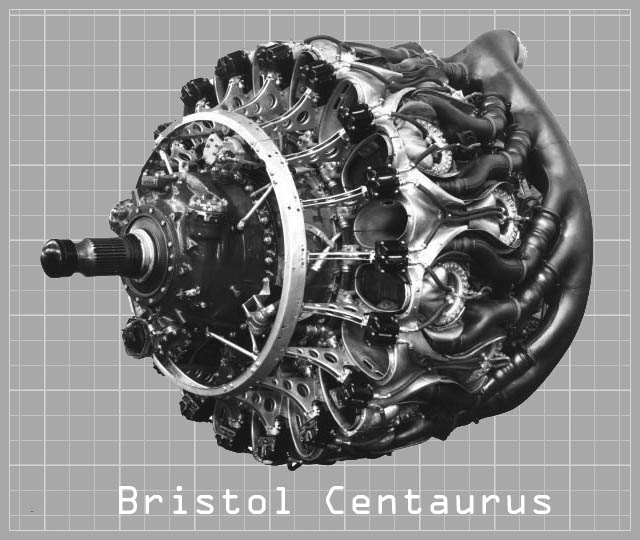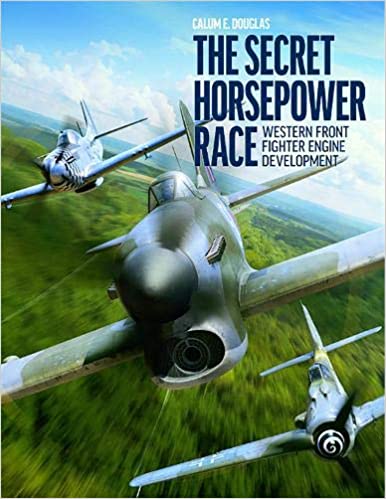Bristol Centaurus
The Centaurus was the final development of the Bristol Engine Company's series of sleeve valve radial aircraft engines. The Centaurus is an 18-cylinder, two-row design that eventually delivered over 3,000 hp (2,200 kW). The engine was introduced into service late in the Second World War and was one of the most powerful aircraft piston engines to see service. The Royal Navy Historic Flight operates a Hawker Sea Fury, powered by a Bristol Centaurus engine.

Bristol Centaurus
Design and development
Like most Bristol Engines designs, the Centaurus was based on the mechanicals of an earlier design, in this case the "classic" 5.75 in (146 mm) piston from their original 1918 Jupiter. The Jupiter piston was in use in the contemporary 14-cylinder Hercules, which was being brought into production when the design of the Centaurus started. The Centaurus had a cylinder swept volume of 3,272 in³ (53.6 l), close to that of the American Wright R-3350 Duplex-Cyclone large radial, making the Centaurus one of the largest aircraft piston engines to enter production, while that of the Hercules was 2,363 cubic inches (38.7 l). The nearly 40 percent higher capacity was achieved by increasing the stroke from 6.5 to 7 in (170 to 180 mm) and by changing to two rows of nine cylinders instead of two rows of seven. The diameter of the Centaurus was only just over 6 percent greater than the Hercules in spite of its much greater swept volume. The cylinder heads had an indentation like an inverted top hat, which was finned, but it was difficult to get air down into this hollow to adequately cool the head. During development, the engineers contacted ICI Metals Division, Birmingham, to enquire whether a copper-chromium alloy with higher thermal conductivity would have sufficient high temperature strength to be used for this purpose. Tests were successful and with the same volume of cylinder, these modified heads enabled the horsepower per cylinder to be raised from 110 hp to 220 hp. Bristol maintained the Centaurus from type-testing in 1938, but production did not start until 1942, owing to the need to get the Hercules into production and improve the reliability of the entire engine line. Nor was there any real need for the larger engine at this early point in the war, when most military aircraft designs were intended to mount engines around 1,000 hp. The Hercules's approximately 1,500 hp was better suited to the existing airframes. The Centaurus did not see service until near the end of the war, first appearing on the Vickers Warwick. Other wartime, or postwar, uses included the Bristol Brigand and Buckmaster, Hawker Tempest and Sea Fury and the Blackburn Firebrand and Beverley. The engine also saw post-war use in civilian airliners, including the ill-fated Bristol Brabazon. By the end of the war in Europe, around 2,500 examples of the Centaurus had been produced by Bristol. The 373 was the most powerful version of the Centaurus and was intended for the Blackburn Beverley transport aircraft. Using direct fuel injection, it achieved a remarkable 3,220 hp, but was never fitted. A projected enlarged capacity version of the Centaurus was designed by Sir Roy Fedden; cylinders were produced for this engine, but it was never built. Known as the Bristol Orion, a name used previously for a variant of the Jupiter engine and later re-used for a turboprop, this development was also a two-row, 18 cylinder sleeve valve engine, with the displacement increased to 4,142 cubic inches (67.9 l) (6.25 × 7.5), nearly as large as the American Pratt & Whitney R-4360 Wasp Major four-row, 28-cylinder radial, the largest displacement aviation radial engine ever placed in quantity production. Variants:
The Centaurus was produced in 34 variants, ranging from the 2,000 hp (1,490 kW) Centaurus I to the 2,405 hp (1,793 kW) Centaurus 663 for the Airspeed Ambassador airliner. The most powerful variants to enter service were the 2,625 hp (1,957 kW) Centaurus 170, 173, 660, 661 and 662. Applications:
General characteristics: (Centaurus VII)
Components
Performance

Bristol Centaurus
Like most Bristol Engines designs, the Centaurus was based on the mechanicals of an earlier design, in this case the "classic" 5.75 in (146 mm) piston from their original 1918 Jupiter. The Jupiter piston was in use in the contemporary 14-cylinder Hercules, which was being brought into production when the design of the Centaurus started. The Centaurus had a cylinder swept volume of 3,272 in³ (53.6 l), close to that of the American Wright R-3350 Duplex-Cyclone large radial, making the Centaurus one of the largest aircraft piston engines to enter production, while that of the Hercules was 2,363 cubic inches (38.7 l). The nearly 40 percent higher capacity was achieved by increasing the stroke from 6.5 to 7 in (170 to 180 mm) and by changing to two rows of nine cylinders instead of two rows of seven. The diameter of the Centaurus was only just over 6 percent greater than the Hercules in spite of its much greater swept volume. The cylinder heads had an indentation like an inverted top hat, which was finned, but it was difficult to get air down into this hollow to adequately cool the head. During development, the engineers contacted ICI Metals Division, Birmingham, to enquire whether a copper-chromium alloy with higher thermal conductivity would have sufficient high temperature strength to be used for this purpose. Tests were successful and with the same volume of cylinder, these modified heads enabled the horsepower per cylinder to be raised from 110 hp to 220 hp. Bristol maintained the Centaurus from type-testing in 1938, but production did not start until 1942, owing to the need to get the Hercules into production and improve the reliability of the entire engine line. Nor was there any real need for the larger engine at this early point in the war, when most military aircraft designs were intended to mount engines around 1,000 hp. The Hercules's approximately 1,500 hp was better suited to the existing airframes. The Centaurus did not see service until near the end of the war, first appearing on the Vickers Warwick. Other wartime, or postwar, uses included the Bristol Brigand and Buckmaster, Hawker Tempest and Sea Fury and the Blackburn Firebrand and Beverley. The engine also saw post-war use in civilian airliners, including the ill-fated Bristol Brabazon. By the end of the war in Europe, around 2,500 examples of the Centaurus had been produced by Bristol. The 373 was the most powerful version of the Centaurus and was intended for the Blackburn Beverley transport aircraft. Using direct fuel injection, it achieved a remarkable 3,220 hp, but was never fitted. A projected enlarged capacity version of the Centaurus was designed by Sir Roy Fedden; cylinders were produced for this engine, but it was never built. Known as the Bristol Orion, a name used previously for a variant of the Jupiter engine and later re-used for a turboprop, this development was also a two-row, 18 cylinder sleeve valve engine, with the displacement increased to 4,142 cubic inches (67.9 l) (6.25 × 7.5), nearly as large as the American Pratt & Whitney R-4360 Wasp Major four-row, 28-cylinder radial, the largest displacement aviation radial engine ever placed in quantity production. Variants:
The Centaurus was produced in 34 variants, ranging from the 2,000 hp (1,490 kW) Centaurus I to the 2,405 hp (1,793 kW) Centaurus 663 for the Airspeed Ambassador airliner. The most powerful variants to enter service were the 2,625 hp (1,957 kW) Centaurus 170, 173, 660, 661 and 662. Applications:
|
|
General characteristics: (Centaurus VII)
- Type: 18-cylinder, air-cooled, two-row radial engine
- Bore: 5.75 in (146 mm)
- Stroke: 7 in (177 mm)
- Displacement: 3,270 in³ (53.6 l)
- Diameter: 55.3 in (1,405 mm)
- Dry weight: 2,695 lb (1,223 kg)
Components
- Valvetrain: Sleeve valve, four ports per sleeve
- Supercharger: Two-speed centrifugal, single stage
- Fuel system: Injection
- Fuel type: 100/130 Octane petrol
- Oil system: Direct-pressure lubrication
- Cooling system: Air-cooled
Performance
- Power output: 2,520 hp (1,880 kW) at 2,700 rpm
- Specific power: 0.77 hp/in³ (35.1 kW/l)
- Compression ratio: 7.2:1
- Power-to-weight ratio: 0.94 hp/lb (1.54 kW/kg)
Source(s):
Wikipedia
Gunston, Bill (2006). World Encyclopedia of Aero Engines: From the Pioneers to the Present Day (5th ed.). Stroud, UK: Sutton. ISBN 0-7509-4479-X.
Wikipedia
Gunston, Bill (2006). World Encyclopedia of Aero Engines: From the Pioneers to the Present Day (5th ed.). Stroud, UK: Sutton. ISBN 0-7509-4479-X.






